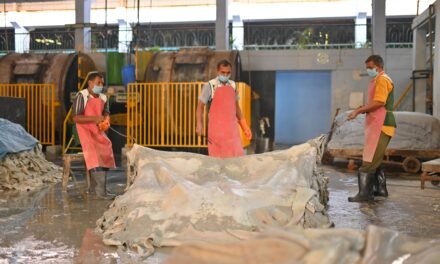The quality control processes in leather jacket production are essential to ensure durability, aesthetics, and customer satisfaction. Below are the key steps involved:
1. Raw Material Inspection
- Objective: Ensure that the leather hides or skins meet quality standards.
- Process:
- Check for defects such as scars, holes, wrinkles, and uneven thickness.
- Assess leather texture, color consistency, and softness.
- Measure leather thickness to match the garment specifications.
2. Pattern and Cutting Quality Check
- Objective: Ensure accurate cutting and minimal leather wastage.
- Process:
- Verify pattern placement to optimize material use.
- Inspect cut pieces for clean edges, proper shape, and size consistency.
- Ensure alignment of leather grain for uniformity in appearance.
3. Skiving Inspection
- Objective: Verify edge thinning for seam flexibility and reduced bulk.
- Process:
- Check that skived edges are uniform and appropriately thinned.
- Ensure no tears or uneven thinning that could affect seam strength.
4. Stitching Quality Control
- Objective: Maintain seam strength, alignment, and aesthetics.
- Process:
- Inspect for:
- Even stitching with consistent tension.
- No skipped stitches, loose threads, or needle holes.
- Proper topstitching and reinforcement at stress points (e.g., pockets, shoulders).
- Verify use of heavy-duty threads suitable for leather garments.
- Inspect for:
5. Seam and Edge Finishing Check
- Objective: Ensure smooth and polished seams for a professional finish.
- Process:
- Inspect pressed seams for flatness and reinforcement.
- Verify edge treatments like burnishing, painting, or sealing are smooth and uniform.
6. Hardware and Accessories Inspection
- Objective: Confirm quality and functionality of zippers, buttons, and linings.
- Process:
- Check zippers for smooth operation and alignment.
- Inspect metal hardware (e.g., buckles, snaps) for strength and corrosion resistance.
- Verify the stitching and attachment of lining materials for durability and comfort.
7. Color and Dye Quality Control
- Objective: Ensure color consistency and proper finishing.
- Process:
- Compare leather color against approved samples under natural and artificial light.
- Verify uniform dyeing with no patchiness or stains.
- Check finishing treatments (e.g., wax, oils) for smoothness and shine.
8. Final Inspection and Fit Check
- Objective: Ensure the finished jacket meets design specifications and fit requirements.
- Process:
- Inspect overall garment for:
- Proper alignment of panels.
- Smooth and even finishing.
- No loose threads, creases, or marks.
- Verify size and fit using measurement tools or dress forms.
- Inspect overall garment for:
9. Functional Testing
- Objective: Check garment durability and functionality.
- Process:
- Perform stress tests on seams, zippers, and hardware.
- Check for:
- Flexibility of leather without cracking.
- Stitch strength under tension.
- Assess comfort and wearability.
10. Packaging Quality Control
- Objective: Prevent damage during storage and shipping.
- Process:
- Ensure jackets are folded or hung properly to avoid creases.
- Use protective materials (e.g., dust bags, tissue paper).
- Verify labeling, tags, and packaging quality.







